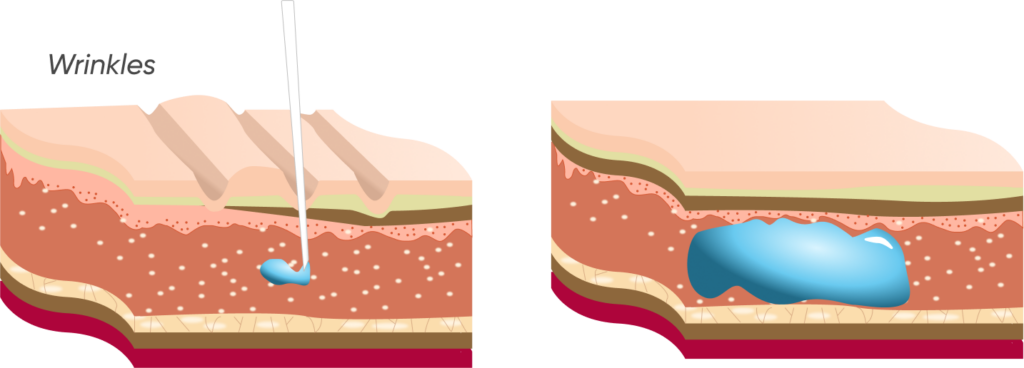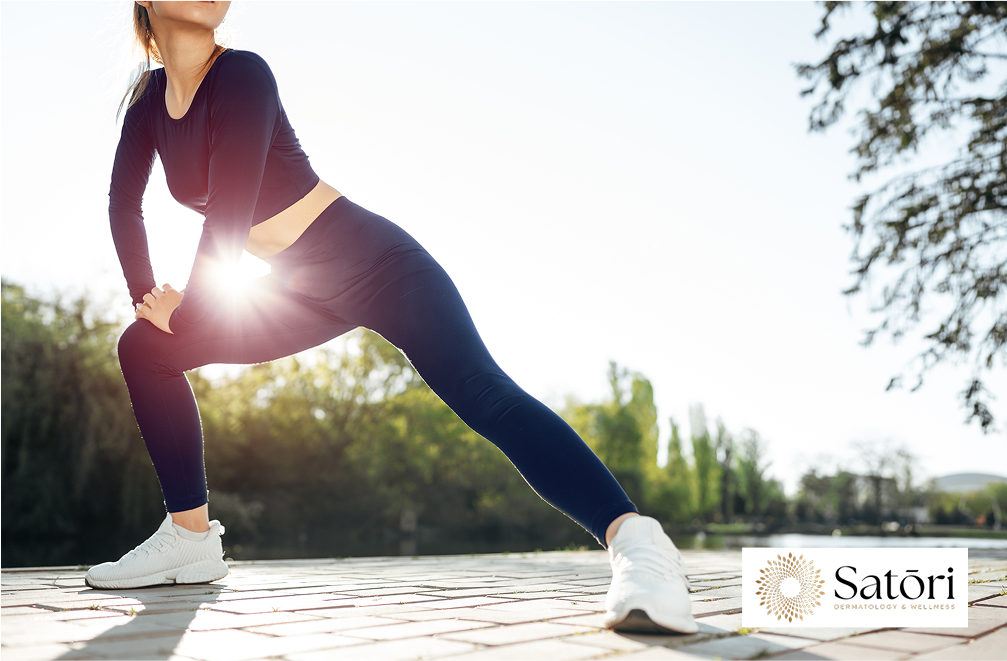One of the most frequent questions we receive from patients following their dermal filler appointment concerns when they can safely return to their regular fitness routines. If you’re wondering about exercising after treatment, you’re certainly not alone. This concern reflects a healthy understanding that your cosmetic treatment requires proper care to achieve optimal results.
The reality is that while dermal filler injections are minimally invasive procedures, they do require a brief modification to your exercise schedule—generally waiting 24-48 hours (we recommend the latter) before returning to your regular workout routine.
Understanding why this temporary adjustment is necessary—and exactly how long you’ll need to modify your routine—will help make sure your filler treatments deliver the beautiful, long-lasting results you’re seeking.

How Dermal Fillers Interact with Your Body’s Systems
When you receive dermal filler treatment, whether hyaluronic acid-based facial fillers or specialized cheek filler treatments, your body initiates a precise healing response around each injection site. This process is fundamental to how dermal fillers work effectively within your facial structure.
During the initial hours following cosmetic injections, your blood vessels undergo increased activity as your body adapts to these facial rejuvenation products. The injection techniques employed by experienced doctors are specifically designed to work harmoniously with your body’s natural processes. However, increased blood flow from strenuous exercise can potentially disrupt this delicate period of integration.
Unlike other cosmetic treatments, such as Botox injections, which primarily affect muscle function, dermal fillers physically add volume to targeted areas of your skin. This distinction is important because it explains why filler injections require specific aftercare protocols to prevent complications like filler migration or excessive bruising and swelling. Patients often ask not only about exercise restrictions after fillers but also where to get Botox® for complementary results that address muscle-related wrinkles. Even though these are considered minimally invasive procedures, the healing process deserves respect and proper attention.
The Science Behind the 48-Hour Exercise Restriction
The recommendation to avoid exercise immediately after getting dermal fillers is grounded in solid medical reasoning. When you engage in physical activity, your body naturally experiences elevated blood pressure and increased blood flow throughout your circulatory system, including the treated area where your cosmetic injections were administered.
This enhanced circulation, while beneficial under normal circumstances, can put unwanted pressure on the injection sites before they’ve had adequate time to stabilize. The risk of bruising increases significantly when blood flow is elevated during this critical settling period. Additionally, patients who exercise too soon after their filler appointment often experience more pronounced initial swelling compared to those who follow proper aftercare instructions.
The process is somewhat analogous to allowing concrete to set – while the material may appear stable on the surface, premature stress can compromise the final result. Whether you’ve received lip injections, cheek fillers, or other facial enhancement procedures, that tiny needle has created precise channels that require undisturbed healing time. This is particularly important because cosmetic procedures, even minimally invasive ones, involve working with your body’s natural aging process and tissue structure.

Evidence-Based Timeline for Returning to Physical Activity
Immediate 48-Hour Period: Complete Exercise Avoidance
During this critical window, it’s essential to avoid any activity that significantly elevates your heart rate or blood pressure. This includes not only obvious activities like gym workouts, running, or cycling, but also tasks like heavy lifting, intense housework, or hot yoga classes.
Light walking is generally acceptable, but you should avoid sleeping on the treated area and exercise caution when applying makeup or using skincare products near the injection site.
Days 3-7: Gradual Activity Reintroduction
You may begin incorporating gentle physical activity back into your routine during this phase. Appropriate activities include light stretching, moderate walking, or basic household tasks that don’t cause strain.
However, continue avoiding exercise that creates significant pressure on the injected area or causes you to strain. This period typically coincides with the natural reduction of bruising and swelling, allowing you to better assess your emerging results.
Week 2 and Beyond: Full Exercise Resumption
By this point, your dermal fillers have properly integrated with your natural tissue structure, and normal blood flow patterns have been reestablished around the injection sites. You can confidently return to your complete exercise routine without concern for compromising your cosmetic treatment results.
Recommended Exercise Timelines by Dermal Filler Type
Not all dermal fillers behave the same post-treatment. While the 48-hour guideline suits most cases, some fillers—due to their density or longevity—require longer rest periods. Here’s a breakdown by product.
Juvederm® (Ultra, Ultra Plus, Voluma, Vollure, Volbella)
- Type: Hyaluronic Acid (HA)
- Recommended Exercise Delay: 48 hours
- These HA fillers integrate quickly but are still susceptible to migration or bruising if physical activity is resumed too soon—especially in the lips and tear troughs.
Restylane® (Classic, Lyft, Kysse, Refyne, Defyne)
- Type: Hyaluronic Acid (HA)
- Recommended Exercise Delay: 48 hours
- Similar to Juvederm, these fillers benefit from two full days of rest before resuming workouts, particularly for under-eye and lip treatments, where tissue is delicate.
Radiesse®
- Type: Calcium Hydroxylapatite
- Recommended Exercise Delay: 72 hours
- This thicker filler stimulates collagen production and is often used for deeper lines or volume restoration in the cheeks or hands. Its denser formulation calls for slightly longer downtime.
Sculptra®
- Type: Poly-L-lactic Acid
- Recommended Exercise Delay: 72 hours
- Since Sculptra works through biostimulation rather than direct volume addition, it requires a bit more recovery time and typically involves multiple sessions.
Belotero Balance
- Type: Hyaluronic Acid (HA)
- Recommended Exercise Delay: 24–48 hours
- This lightweight filler is often used for fine lines and superficial corrections. Downtime is generally minimal, but 48 hours is still the safest guideline.
Bellafill
- Type: Polymethyl Methacrylate (PMMA)
- Recommended Exercise Delay: 5–7 days
- As a semi-permanent filler, Bellafill requires more conservative aftercare. Inflammatory response and nodule formation are potential risks if stress is applied too soon.

Comprehensive Aftercare Guidelines for Optimal Results
Proper post-treatment care extends beyond exercise modifications. To maximize the effectiveness of your filler treatments and minimize potential complications, avoid skincare products containing vitamin E or other blood-thinning ingredients for several days following your procedure, as these can increase the likelihood of delayed bruising.
Regarding cosmetic products and makeup application, wait a minimum of 24 hours before applying anything directly to the treated area. Similarly, face masks should be avoided initially, as they may apply unnecessary pressure to newly injected sites.
If you experience swelling, you may apply ice for brief periods, but always use a protective barrier such as a soft cloth to prevent direct contact with your skin.
The importance of working with experienced dermatologists and doctors cannot be overstated. Qualified practitioners who understand advanced injection techniques and evidence-based aftercare protocols will provide personalized aftercare instructions tailored to your specific treatment and individual needs. They can also advise you about interactions with other cosmetic treatments you may be considering and help you avoid harsh chemicals or products that might interfere with your healing process.
It’s also worth noting that certain activities beyond exercise should be temporarily avoided, including tanning beds, which can increase inflammation, and treatments involving significant facial manipulation. Your practitioner will provide specific guidance about when you can safely resume these activities and when it’s appropriate to immediately return to your normal skincare routine.
Maximizing Your Investment Through Proper Care
The temporary modification of your exercise routine following dermal filler injections represents a small but crucial investment in achieving superior results. This brief adjustment period, which again, we recommend waiting the full 48 hours, helps make sure that your cosmetic treatment provides the natural-looking enhancement you’re seeking.
By following these evidence-based guidelines, you’re not limiting your active lifestyle; you’re optimizing the integration of your facial rejuvenation products with your body’s natural processes. The patience you demonstrate during this recovery period will be rewarded with results that can enhance your appearance and confidence for months to come, allowing you to enjoy both your improved appearance and your regular fitness routine with complete peace of mind.

